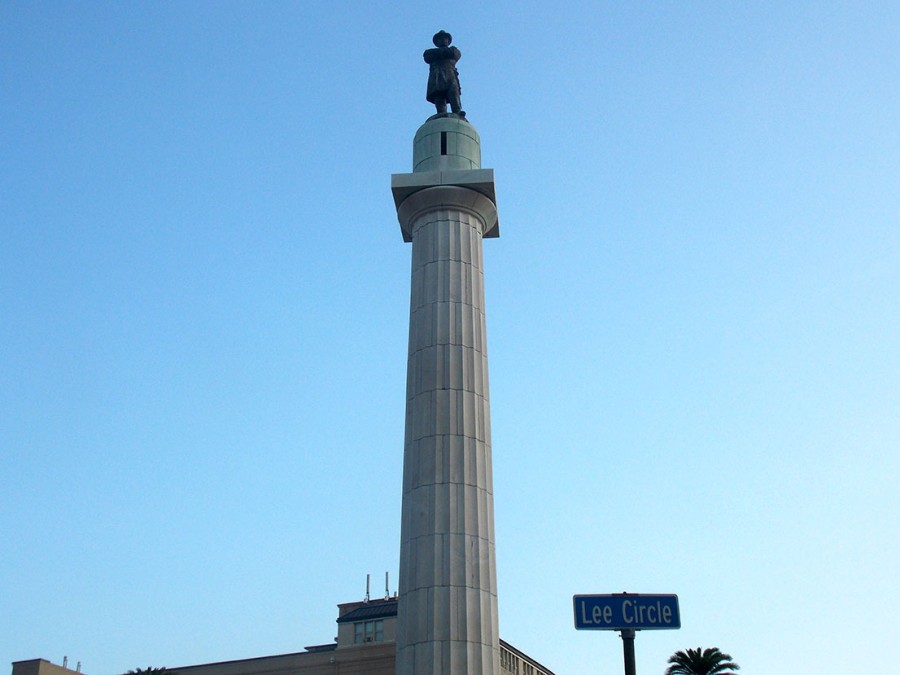Confederate monuments are a political move, not a historical one
January 28, 2016
Several preservation organizations have rallied together to prevent the removal of four confederate monuments by taking the case to federal court.
After the New Orleans City Council voted 6-1 on Dec. 17, 2015 to remove the memorials, the Monumental Task Committee, Louisiana Landmarks Society, Foundation of Historical Louisiana and the Sons of Confederate Veterans New Orleans chapter, Beauregard Camp No. 130, filed a lawsuit against the city of New Orleans and the federal Department of Transportation.
The hearing for this lawsuit took place in the U.S. District Court, Jan. 14, 2016.
Even though the Council voted to remove the monuments of Robert E. Lee at Lee Circle, P.G.T. Beauregard in City Park, Jefferson Davis in Mid-City and the obelisk commemorating the Battle of Liberty Place on Iberville Street, Fred Adolphus, the Heritage Defense Chief of Sons and Confederate Soldiers, said it is important to his organization for the Confederate statues to stay.
“We feel that the monuments are a tribute to soldier valor and to our Southern heritage, which is a part of the nation’s history,” Adolphus said. “We have a right to have our history as a part of the collective consciousness. We look upon their removal as ethnic cleansing.”
While Adolphus understands that the Civil War evokes negative feelings, such as racism, he said that is not why his group wants to keep the monuments.
“The Sons of Confederate Veterans harbors no ill-will against the Black community, nor do we condone slavery. We acknowledge that all peoples have good and bad in their history, and that despite any shortcomings, all people still have a right to their existence and to their positive history,” Adolphus said. “We want the monuments to remain as symbols of our people’s history and contributions to the country.”
Mark Fernandez, professor of history at Loyola University, said the issue of taking down the statues started after the school shootings in South Carolina, and New Orleans Mayor Mitch Landrieu wanted to take action on the issue.
“The larger issue of removing statues and renaming streets, etc. has been around for several decades. The recent incidents in Charleston seemed to revive those efforts,” Fernandez said.
Justin Nystrom, assistant history professor and expert in Southern history, Civil War and Reconstruction, said that it was interesting how a few moments in time could change how a country views something that has been around for decades.
“It would have been difficult, after all, to have predicted only five years ago that, as a city, we would be considering removing what had then been an innocuous bronze equestrian statue of Beauregard,” Nystrom said. “The greatest irony to all of this is that the White League monument, which is by far the most offensive, is the best protected under the law because of earlier court orders.”
Yet, with all the arguments claiming that the monuments must stay for historical purposes, Nystrom said that the removal of Confederate symbols is more of a political issue than a historical one.
“Supporters include those who genuinely think the monuments are racially offensive, as well as others who simply yearn for the appearance of being a racially sensitive progressive,” Nystrom said. “The monument supporters include historians and antiquarians who seem by nature to resist change and the erasure of landmarks, people who mistrust or oppose Mitch specifically or the Landrieu political family generally, and certainly many who harbor racist feelings or are simply glad that these monuments offend their political opponents.”
While there are many reasons why people are in favor of holding onto the monuments, Fernandez said that people who have no family attachment to these monuments are under false impressions about the matter due to education.
“I do believe that others without those associations are influenced by the education they received in the 20th century that was influenced by the lost cause ideology that emphasized that the war was more about states’ rights rather than slavery. ‘War Between the States’ as opposed to ‘The Civil War,'” Fernandez said.
Nystrom said that modern supremacists have been using Confederate symbolism for a long time. Because of this close association, Nystrom believes that by removing the monuments, more legal challenges may arise in the future.
“The Union accorded the Confederacy recognition under the rules of war. Lee and Beauregard were both pardoned after the war, though never regained full citizenship. It is difficult to predict what the judiciary will do, but it is possible that the monuments will be protected by the courts,” Nystrom said. “If the Landrieu administration prevails, however, it is conceivable that the process will set a precedent for the removal of other politically vulnerable monuments in the future.”
On Jan. 26, it was decided by a federal judge that there would be no injunction placed to delay or ban the removal of the monuments while the case pans out.
While the city has said that they plan to hold the monuments in a warehouse until a permanent location can be found, Adolphus said he hopes they are moved to a place with the respect they deserve.
“We would hope that they are moved to a venue where they will be interpreted sympathetically rather than in a manner that denigrates Southerners,” Adolphus said.






